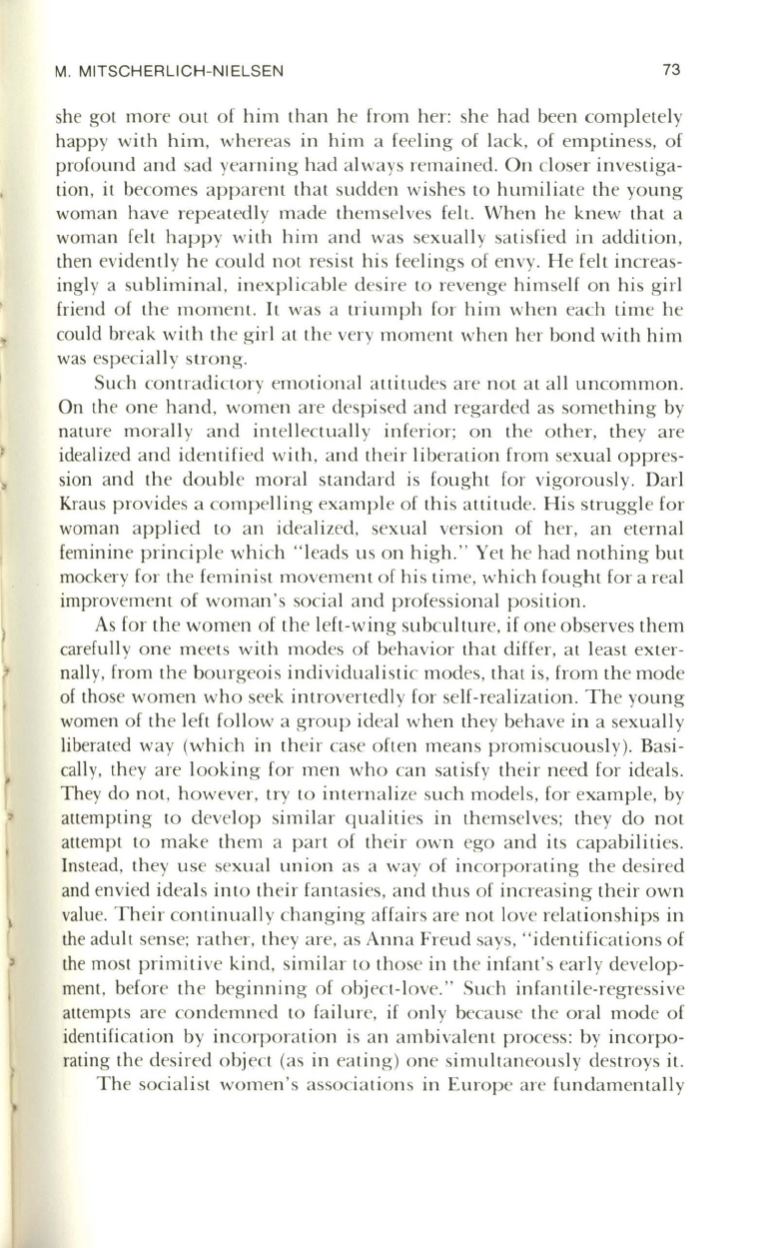
M, MITSCHERLICH-NIELSEN
73
she got mo re out o f him than he from her: she had been compl etely
happy with him, whereas in him a feeling of lack, of emptiness, of
profound and sad yea rning had always rema ined. On closer in vestiga–
tion , it becomes appa rent tha t sudden wishes to humili ate the young
woman have rep ea tedl y made themselves felt. When he knew th at a
woman felt happy with him and was sexua ll y sa ti sfi ed in additi on ,
then ev identl y h e could no t res ist hi s feelings o f envy. He felt increas–
inglya subliminal, inexpli ca bl e des ire to revenge himself on hi s girl
fri end of the moment.
It
was a triump h fo r him when each time he
could break with the g irl at th e very moment wh en her bond with him
was especia ll y strong ,
Such contradi ctory emo tiona l a ttitudes are no t a t a ll uncommon .
On the one hand, women a re despi sed and regarded as something by
nature mora ll y and intell ectua ll y inferi o r; on the o ther, they are
idealized and identifi ed with , and th eir libera ti on from sexual oppres–
sion and the do ubl e mo ra l standa rd is fou ght for vigorousl y. Da r!
Kraus provides a compelling exampl e of thi s a ttitude. Hi s struggle fo r
woman appli ed to an idea li zed, sexua l version of her, an etern al
feminin e principl e whi ch " leads us on hi gh ." Yet he had n o thing but
mockery fo r the femini st movement of hi s time, whi ch fought fo r a rea l
improvement of woman 's socia l and professiona l positi on.
As fo r the women of the left-win g subculture, if one o bserves them
carefull y one meets with modes of behav io r tha t differ, a t least exter–
nall y, from the bourgeo is individua li sti c modes, tha t is, from the mode
of those women who seek introvertedl y fo r self-rea li za ti on . The young
women of the left fo ll ow a group idea l when they behave in a sexua ll y
liberated way (whi ch in their case often means promi scuou sly ). Basi–
call y, th ey are looking fo r men who can sati sfy their need for ideals.
They do no t, however, try to intern a li ze such models, for exampl e, by
attempting to develop simil ar qua liti es in themselves; they do no t
attempt to make them a pa rt of their own ego and its capabilities.
Instead, they u se sexua l uni on as a way of incorpo ra ting the desired
and envi ed idea ls into their fantas ies, and thus of increasing their own
value. Th eir continua ll y changing affa irs are not love rela tionships in
the adult sen se; ra th er, th ey a re, as Anna Freud says, " identificati ons of
the most primitive kind , simil ar to those in th e infant 's earl y develop–
menl, before th e beginning of o bj ect-l ove." Such infantil e-regressive
attempts are condemned to failure, if onl y because the o ral mode of
identifi ca ti on by in corpo ra ti on is an ambivalent process: by incorpo–
rating the desired o bj ect (as in ea ting) one simultaneously destroys it.
The socia list women 's associa ti on s in Europe a re fund amenta ll y


